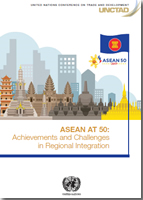
The impact of finance-driven globalization, particularly after it triggered the 2008 financial crisis, has compelled politicians, policymakers and citizens to become involved in the debate over the future of the global economic system to deliver inclusive and sustainable outcomes for all. These discussions about globalization have also instigated a debate on the effectiveness and accountability of global institutions and reinvigorated arguments for greater regional integration. As the Association of South-East Asian Nations (ASEAN) celebrates its 50th anniversary, it is a propitious time to take stock of the organization's track record on regional economic integration to spur economic development in member countries.
In the past, successful experiments in regionalism involved greater integration of economies at similar stages of development. From this perspective, ASEAN represents an alternative approach that incorporates a broader range of economic and policy experiences. For example, unlike regional agreements such as the European Union and the North American Free Trade Agreement, ASEAN is a more flexible arrangement that emphasizes consensus-building and informal norms, instead of legalistic structures and independent enforcement of the rules.
Although ASEAN is sometimes criticized for the slow pace of implementing its plans, the 50th anniversary of ASEAN comes at an "inflection point" in economic globalization, when the standard approaches to liberalization, privatization and free trade agreements have ceased to be the default policy option due to growing doubts about the economic outcomes these have delivered, and increasing political disaffection and opposition. In this sense, ASEAN's institutional style of regional integration may be slower but more politically viable in the longer run - as one commentator put it, ASEAN never progresses in a linear fashion; it is like a crab that moves "two steps forward, one step backwards and one step sideways", but progress has been no less tangible.
In many respects, the crux of ASEAN integration has largely been a story of the "old trade agenda" of "at-the-border" measures, particularly tariff reduction. This agenda has helped sustain export expansion, economic growth, and improvements in poverty reduction and social indicators, that compare favourably with most other developing regions of the world. As the regional agenda turns to "behind-the-border" measures, it is an open question whether this kind of deeper integration can propel the more developed member countries from middle-income to high-income status (aside from Singapore). In particular, as engagement with global value chains (GVCs) has become conventional wisdom in contemporary development strategy, ASEAN's experience provides an important touchstone for other developing countries due to the region's reliance on foreign direct investment to lead export diversification and industrialization.
In this way, ASEAN's development model is distinctive from that of East Asia's, which explicitly sought to sustain very high rates of domestic capital formation and to foster "national champions" in technology- and capital-intensive manufacturing sectors. It would be wrong to draw direct policy lessons or to blindly imitate the East Asian model, but given its success in reaching high-income status, the history of East Asian development may well provide subtle yet useful insights for ASEAN countries. For instance, well-established structural barriers to industrial upgrading in GVCs suggest that ASEAN may need to pragmatically pursue a new policy direction over the coming years. Indeed, openings to strategically modify the "ASEAN model" may be more feasible under a backdrop of shifting global economic norms and governance, especially at the regional level, with increasing competitive engagement by major powers with ASEAN.
Following a review of ASEAN integration across key policy areas, the paper proposes a strategic shift in the "ASEAN Way" model and vision that could drive progress towards the region's development ambitions over the next 50 years.
Sections II and III provide a brief background of the institutional evolution of ASEAN and ASEAN Economic Community, followed by a summary of broad economic achievements over the past five decades. Sections IV and V assess the state of ASEAN regional integration and implementation in the areas of goods and services trade, and investment and finance, respectively. Section VI examines the issue of infrastructure cooperation in the ASEAN region, with a focus on various regional and subregional initiatives. Section VII analyses the export diversification of ASEAN member countries in GVCs using a "catch-up" development framework. This section also includes two case studies that explore the challenges and opportunities in upgrading, as well as regional trends in science, technology and innovation. Section VIII suggests a strategic shift in the "ASEAN Way" model and provides concluding remarks on events shaping its evolution, with emphasis on the role of China in regional development finance.



